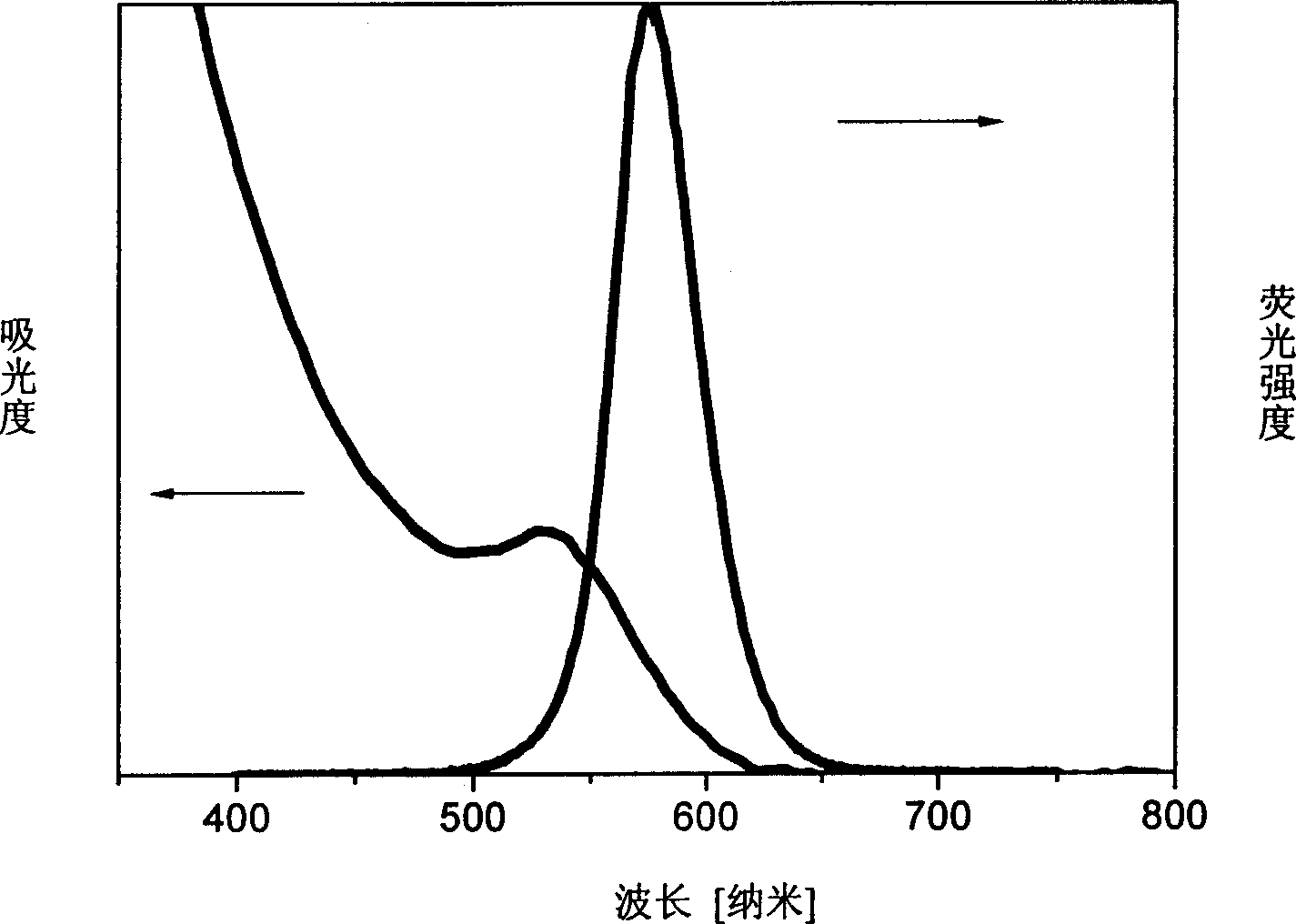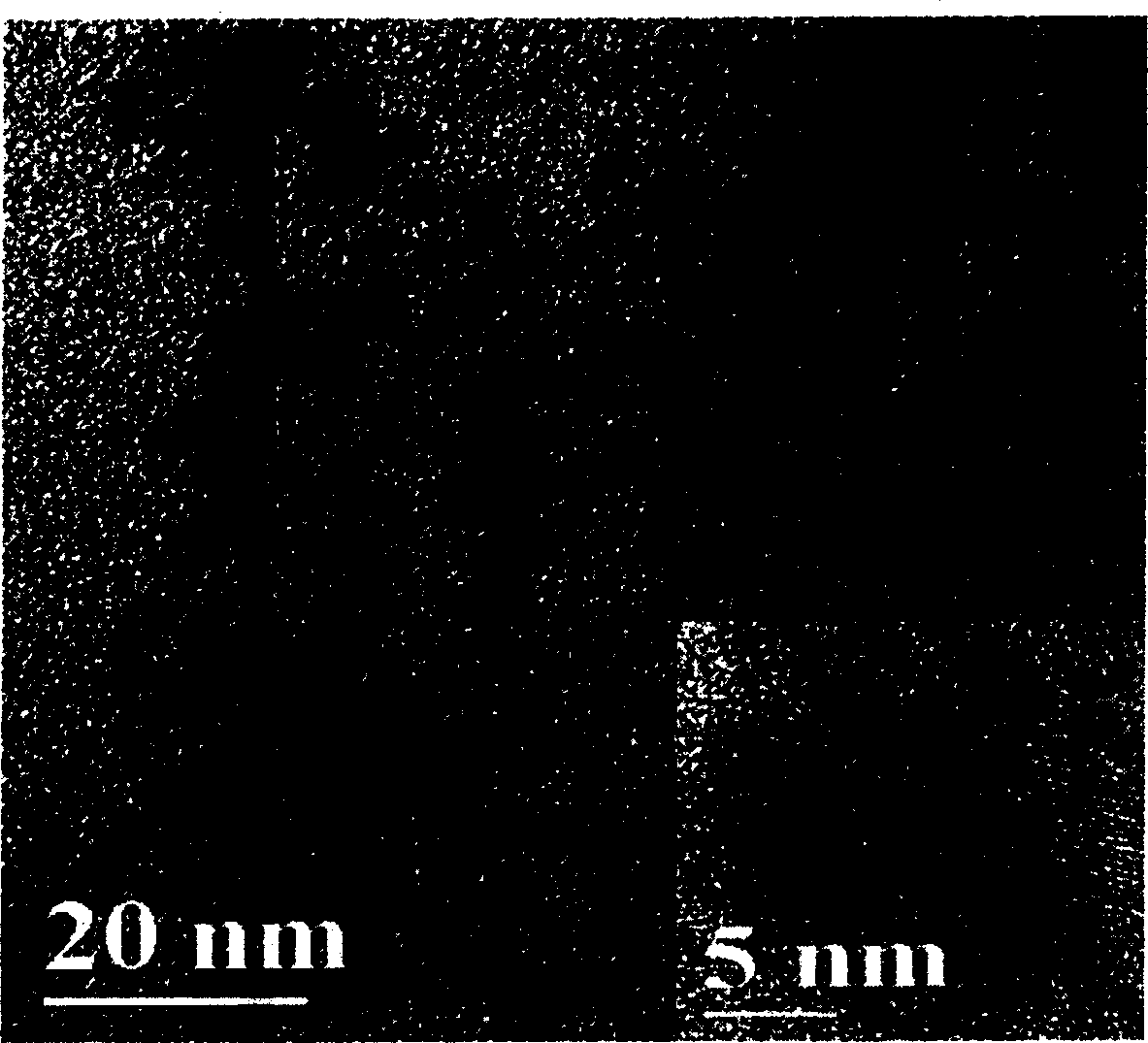Process for preparing water soluble cadmium telluride quantum point with program controlling microwave
A cadmium telluride quantum dot, water-soluble technology, applied in the field of nanomaterials and biological analysis and detection, can solve the problems of long reaction time (several hours to tens of hours, increased surface defects of quantum dots, low luminous efficiency of quantum dots, etc.) Achieving the effects of good water solubility, high fluorescence properties, high quantum yield, and safe and easy availability of raw materials
- Summary
- Abstract
- Description
- Claims
- Application Information
AI Technical Summary
Problems solved by technology
Method used
Image
Examples
Embodiment 1
[0015] (1). Preparation of sodium telluride hydride:
[0016] 80 mg NaBH 4 Put the solid and 91.2 mg of Te powder into a small flask, add 2 ml of water, and react at 10 degrees Celsius for 10 hours to obtain a NaHTe solution for use;
[0017] (2) Preparation of CdTe precursor solution
[0018] 21.9 mg CdCl 2 Dissolve in 100 ml of water, add 0.03 ml of thioglycolic acid, adjust the pH to 10 with 0.5 mol / L NaOH solution, inject 0.2 ml of NaHTe solution as the CdTe precursor solution;
[0019] (3) Program controlled microwave irradiation to prepare CdTe quantum dots
[0020] The obtained CdTe precursor solution is subjected to program-controlled microwave radiation to obtain CdTe quantum dots. The program control conditions are as follows:
[0021] The first program microwave power: 50W; the first program temperature: 70°C; the first program time: 30s;
[0022] Second program microwave power: 100W; second program temperature: 120°C; second program time: 1min.
Embodiment 2
[0024] (1). Preparation of sodium telluride hydride
[0025] 92.7 mg NaBH 4 Put the solid and 127.6 mg of Te powder into a small flask, add 3 ml of water, and react at 15 degrees Celsius for 7 hours to obtain a NaHTe solution for use;
[0026] (2) Preparation of CdTe precursor solution
[0027] 30 mg CdCl 2 Dissolve in 100 ml of water, add 0.03 ml of mercaptoacetic acid, adjust pH=9 with 0.5 mol / L NaOH solution, inject 0.3 ml of NaHTe solution as CdTe precursor solution;
[0028] (3) Program controlled microwave irradiation to prepare CdTe quantum dots
[0029] The obtained CdTe precursor solution is subjected to program-controlled microwave radiation to obtain CdTe quantum dots. The program control conditions are as follows:
[0030] The first program microwave power: 70W; the first program temperature: 80°C; the first program time: 60s;
[0031] Second program microwave power: 300W; second program temperature: 110°C; second program time: 5min.
Embodiment 3
[0033] (1). Preparation of potassium hydride telluride:
[0034] 110.5 mg KBH 4 Put the solid and 91.6 mg of Te powder into a small flask, add 3 ml of water, and react at 0 degrees Celsius for 20 hours to obtain a KHTe solution for later use;
[0035] (2) Preparation of CdTe precursor solution
[0036] 36.8 mg CdCl 2 Dissolve in 100 ml of water, add 0.05 ml of mercaptoacetic acid, adjust the pH to 11.0 with 0.5 mol / L NaOH solution, inject 0.30 ml of KHTe solution as the CdTe precursor solution;
[0037] (3) Program controlled microwave irradiation to prepare CdTe quantum dots
[0038] The obtained CdTe precursor solution is subjected to program-controlled microwave radiation to obtain CdTe quantum dots. The program control conditions are as follows:
[0039] The first program microwave power: 70W; the first program temperature: 90°C; the first program time: 30s;
[0040] Second program microwave power: 500W; second program temperature: 100°C; second program time: 10min. ...
PUM
 Login to View More
Login to View More Abstract
Description
Claims
Application Information
 Login to View More
Login to View More - R&D
- Intellectual Property
- Life Sciences
- Materials
- Tech Scout
- Unparalleled Data Quality
- Higher Quality Content
- 60% Fewer Hallucinations
Browse by: Latest US Patents, China's latest patents, Technical Efficacy Thesaurus, Application Domain, Technology Topic, Popular Technical Reports.
© 2025 PatSnap. All rights reserved.Legal|Privacy policy|Modern Slavery Act Transparency Statement|Sitemap|About US| Contact US: help@patsnap.com


